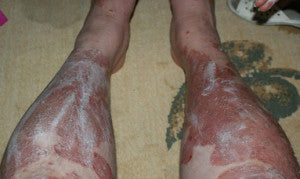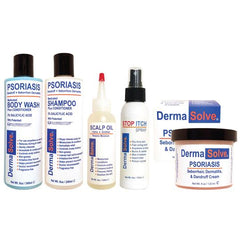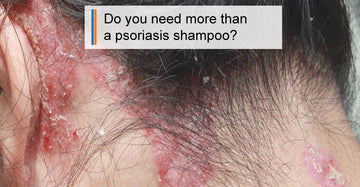
How Do You Treat Psoriasis?
One of the most common search phrases for psoriasis on the internet is – How do you treat psoriasis? Since there is no cure, learning how to treat psoriasis can be very important for people who suffer with this skin condition. Before discussing the treatment options it is important to understand that there are different types of psoriasis. Below is a brief overview of each one.
Types of Psoriasis
Plaque Psoriasis
This is the most common and recognized form of psoriasis. Plaque psoriasis causes the dry and raised red skin that most people identify with the disease. These red lesions or “plaques” are often covered with silvery scales and are circular to oval in shape. Plaque psoriasis can occur any where on the body and can itch or even be painful in severe cases. Plaque psoriasis can even be found on the genitals and on the soft tissue inside your mouth. Since plaque psoriasis is commonly found on the elbows and knees, the area around the joints may crack and bleed due to the severe dryness.
Guttate Psoriasis
Guttate Psoriasis is the second most common form of psoriasis. The lesions associated with Guttate psoriasis are normally small and are either round or tear drop in shape. Guttate psoriasis is usually found in younger individuals and is often brought on by a bacterial infection such as strep throat. The sores associated with this type of psoriasis are not as thick as with plaque psoriasis and are not as scaly. Guttate psoriasis may go away on its own as soon as the infection is gone. Typically Guttate psoriasis occurs on the trunk, arms or legs. However, it may also cover a large portion of the body.
Inverse Psoriasis
This form of psoriasis mainly occurs in areas where the skin overlaps. Common areas are the armpits, under the breasts, in the groin area and around the genitals. Friction and sweat can often make this form of psoriasis worse. Inverse psoriasis usually appears as smooth red patches that may be inflamed or irritated. This type of psoriasis is more common in overweight individuals. The overgrowth of yeast may actually trigger the skin lesions of this type of psoriasis.
Pustular Psoriasis
This form of psoriasis is uncommon and makes up only a small percentage of all the reported cases. Pustular psoriasis comes on quickly. Pus-filled blisters can appear within hours and the skin will be red and irritated. These blisters often come in cycles. They will dry and disappear after a day or so and then reappear in a few days. This is one form of psoriasis in which additional side affects such as fever, fatigue, chills and itching can occur. Pustular psoriasis can appear in small areas on the hands and feet or can be wide spread over large areas of the body.
Erythrodermic Psoriasis
This is probably the rarest form of psoriasis but can be quite serious. In most cases it will cover an entire body with a red rash that will peel, itch and burn. The increased blood flow to the psoriasis areas can put a strain on the heart. It is believed that erythrodermic psoriasis can be brought on by severe sunburn or certain types of medications. Sometimes other forms of psoriasis can turn into erythrodermic psoriasis if they are not kept under control.
So How Do You Treat Psoriasis When There Are 5 Different Types?
If you suffer with one of the uncommon forms of psoriasis such as pustular or erythrodermic, or you have a severe case of one of the other forms, then professional medical attention should be obtained before attempting any treatments. For the other three types of psoriasis you should follow these steps.
1) Most cases of psoriasis can be controlled by using quality over-the-counter drug products that can be found at your local pharmacy. Legitimate psoriasis treatment products will have a DRUG FACTS box on the labeling that will list an active ingredient. If you do not see a drug facts box and the product claims to work for psoriasis then it is most likely nothing more than a moisturizer. The FDA has clearly defined specific ingredients and the percentage of the ingredient that should be used for it to be effective in treating psoriasis. Next determine which products you need. Do you only have it on your body? Or is it on your body and scalp? If you only have psoriasis on your body then look for a quality bodywash and cream combination to use daily. If you also have scalp psoriasis you should look at adding a psoriasis shampoo and possibly a scalp oil to help with removing scaling on the head. Because the active ingredients are regulated they will likely be the same in most of these products. What makes a great product is one that also includes quality moisturizing and nourishing ingredients. These may be a little more expensive but will be well worth the cost. If the first product you try does not work do not give up. It is very common for a product to work for one person and not another. Once you find something that works for you continue to use it to control your psoriasis. It is important to note that these products will sometimes stop working after a while because your body becomes used to them. To avoid this from happening some people swap between two different products every few months.
2) If the over-the-counter products are not fully helping your condition then you may want to add in some light therapy to your treatment. Light therapy is literally letting your skin get exposed to sunlight through a sunlamp. This can be done under a controlled doctors experience or you can purchase a sunlamp for in home treatments. The UVA and UVB rays help the body produce natural vitamin D which has been shown to be very effective in the treatment of psoriasis.
3) Lastly, if OTC products and light therapy are not working as a last resort you should consult your doctor about trying a prescription product. Please be sure to ask your doctor to explain all the side effects that can be associated with these products. Prescription psoriasis products can affect your immune system so you need to be very careful when committing to long term use of one of these products.
Psoriasis is ugly and embarrassing but it does not need to be the end of a normal healthy lifestyle. People are living happy lives every day by keeping their psoriasis under control. By following a daily treatment routine you should be able to avoid having to Google; How do you treat psoriasis.







